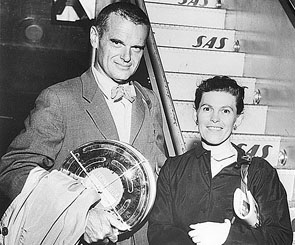 |
| Charles (1907-1978) and Ray Eames (1912-1988). |
After Charles divorced his wife of 12 years and mother of his daughter, named Lucia, Charles Eames married his second wife in 1941. He married his Cranbrook colleague Ray Kaiser. Mrs. Bernice Alexandra "Ray" Eames met Charles while preparing models and drawings for the "Organic Design in Home Furnishings" competition in September of 1940. Tsk Tsk.. dating before you're even officially divorced.
In 1943, 1944, and 1947, Ray Eames designed several covers for the reputable magazine, Arts & Architecture. She also had two of several textile designs produced by the company Schiffer Prints. So yeah, Ray can stand on her own two feet. Though, it is agreeable that Mrs. Ray was very involved and important in the designs with her husband. The Eames fabrics were mostly designed by her.
The Eames continued to be innovative in the 1950's, using plastic resin chairs and the wire mesh chairs designed for Herman Miller.
Throughout the mid to late 50's and into the 60's and 70's, Charles designed many exhibitions:
- Textiles and Ornamental Arts of India (1955)
- Glimpses of the USA (seven screens for the American exhibition in Moscow, Sokoolniki Park) (1959)
- Mathematica (for IBM, 1961)
- IBM Pavilion at the 1964 New York World's Fair
- Nehru: The man and his India (1965)
- The World of Franklin and Jefferson (1975) built for the US Bicentennial Commission opens in Paris, travels to five other countries and the US.
Eames films include:
- Traveling Boy (1950)
- Blacktop: A Story of the Washing of a School Play Yard (1952)
- Parade Parade Or Here They Are Coming Down Our Street (1952)
- A Communications Primer (1953)
- House: After Five Years of Living (1955)
- Day of the Dead (1957)
- Toccata for Toy Trains (1957)
- Kaleidoscope Jazz Chair (1960)
- Powers of Ten (1968, rereleased in 1977)
- Image of the City (1969)
- Banana Leaf (1972)
- Fiberglass Chairs
- SX-70
- Eames Lounge Chair
No doubt they are part of America's most influential and important industrial designers!
No comments:
Post a Comment